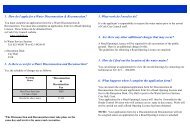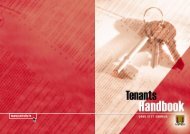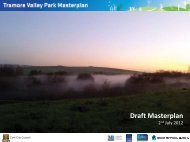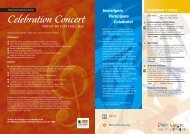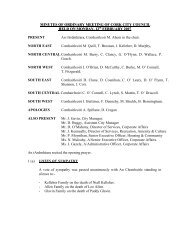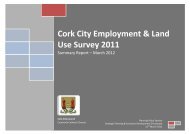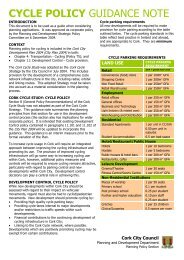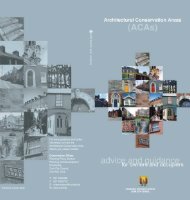Untitled - Cork City Council
Untitled - Cork City Council
Untitled - Cork City Council
Create successful ePaper yourself
Turn your PDF publications into a flip-book with our unique Google optimized e-Paper software.
<strong>Cork</strong> Strategic Retail Study<br />
Study Area. The centres in the Outer Metropolitan Area and elsewhere in <strong>Cork</strong><br />
County provide a more limited range of comparison goods. Effectively they serve<br />
the main food shopping trip and provide for relatively localized comparison goods<br />
needs.<br />
Future Retail Requirements<br />
6 Future requirements for additional retail provision are driven by population growth<br />
and changes in consumer spending on shopping. Consumer spending per capita in<br />
the Study Area is higher than the national average and generally higher than the<br />
other conurbations except Greater Dublin. For the Study Area as a whole we<br />
project an increase of €574 million of convenience goods spending to support<br />
additional turnover within existing shops and new retail development – i.e excluding<br />
SFT (special forms of trading). Similarly, for comparison goods we project an<br />
increase of €2,269 million, including potential inflows from outside the County.<br />
7 Clearly not all this expenditure growth will be available for new development; some<br />
will go to currently committed retail proposals which are under construction or have<br />
planning permission, and some of the growth in consumer spending will be<br />
absorbed by sales density growth within existing shops which over time effectively<br />
enhance their productivity. Overall we estimate a surplus of potential convenience<br />
goods spending to support new development of some €410 million by 2020; the<br />
corresponding figure for comparison goods shops is €1,639 million. In Table 2 we<br />
set out our recommended distribution of additional floorspace in response to<br />
spending changes and reflecting the different sales densities which are likely to be<br />
achieved for the main retail formats in different locations.<br />
Table 2 : Strategy For Future Development 2007 – 2020 (m 2 net)<br />
Convenience<br />
Comparison<br />
<strong>Cork</strong> <strong>City</strong> Centre } 12,040 77,460<br />
<strong>Cork</strong> Suburbs } 26,580<br />
Outer Metro Area 27,440 22,090<br />
Ring Towns 5,590 19,170<br />
Other County <strong>Cork</strong> 5,860 20,470<br />
Retail Warehouses - 93,440<br />
TOTAL 50,930 259,210<br />
Notes: (1) These guidelines are rounded to the nearest 10 square metres<br />
(2) The areas shown for convenience goods are an average of the large format and<br />
medium sized supermarket format scenarios<br />
(3) Figures for the <strong>City</strong> centre include Docklands and other neighbourhood centres<br />
8 Up to 2013, committed convenience and comparison goods development roughly<br />
matches projected expenditure growth, although there is a clear short term need to<br />
bring forward more foodstore development in the Outer Metropolitan Area.<br />
However, given the long lead time for retail development, particularly town centre or<br />
edge-of-centre development, it is important to plan now for development which will<br />
be built and occupied in 2013 or shortly afterwards. The key strategy<br />
recommendations for the main areas is summarized below.<br />
Roger Tym & Partners with Simon Clear & Associates<br />
March 2008<br />
ii



